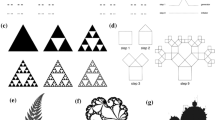Abstract
In this paper, we present an efficient fractal method for detection and diagnosis of mass lesion in mammogram which is one of the abnormalities in mammographic images. We used 110 images that were carefully selected by a radiologist, and their abnormalities were also confirmed by biopsy. These images included circumscribed benign, ill-defined, and spiculated malignant masses. Firstly, we discriminated lesions automatically using new fractal dimensions. The results which were examined by different types of breast density showed that the proposed method was able to yield quite satisfactory detection results. Secondly, noting that contours of masses playing the most important role in diagnosis of different mass types, we defined new fractal features based on information extraction from the contours. This information is able to identify the roughness in mass contours and determines the extent of spiculation or smoothness of the masses. In this manner, in classification of the spiculated malignant masses from the circumscribed benign tumors, we achieved highly satisfactory results, i.e., 0.98 measured in terms of area under ROC curve (AUC). In this paper, it is also shown that the roughness in contours is a suitable characteristic feature for diagnosis of ill-defined malignant tumors with AUC equal to 0.94 in their classification. The extracted information was also found to be useful in the classification of early malignancies whereas in the classification of spiculated and ill-defined malignant masses in their early stage from those of benign tumors, we achieved high accuracy of 0.99 and 0.90 for AUC, respectively.



Similar content being viewed by others
References
Harvey JA, Nicholson BT, Cohen MA: Finding early invasive breast cancers: A practical approach. 248(1):61-76, 2008
Kopans DB: Breast imaging, 3rd Edition. Lippincott Williams & Wilkins, , 2007, 388-408
Rangayyan RM, Oloumi F, Nguyen TM: Fractal analysis of contours of breast masses in mammograms via the power spectra of their signatures. 32nd Annual International Conference of the IEEE EMBS, Buenos Aires, Argentina, 2010,pp 6737-6740
Chen D, Chang R, Chen C, Ho M, Kuo S, Chen S, Hung S, Moon WK: Classification of breast ultrasound images using fractal feature. J Clinical Imaging 29:235–245, 2005
Tourassi GD, Delong DM, FloydJr CE: A study on the computerized fractal analysis of architectural distortion in screening mammograms. Institute of Physics Publishing, Phys. Med. Biol 51:1299–1312, 2006
Guo Q, Shao J, Ruiz VF: Characterization and classification of tumor lesions using computerized fractal-based texture analysis and support vector machines in digital mammograms. Int J CARS 4:11–25, 2009
Raguso G, Ancona A, Chieppa L, L’Abbate S, Pepe ML, Mangieri F, Palo MD, Rangayyan RM: Application of fractal analysis to mammography: 32nd Annual International Conference of the IEEE EMBS, Buenos Aires, Argentina,2010, pp 3182-3185
Rangayyan RM, Nguyen TM: Fractal analysis of contours of breast masses in mammograms. J Digital Imaging 20(3):223–237, 2007
Abdaheer MS, Khan E: Shape based classification of breast tumors using fractal analysis. IEEE, 978-1-4244-3604-0/09, 2009
Nguyen TM, Rangayyan RM: Shape analysis of breast masses in mammograms via the fractal dimension. IEEE Eng Med Bio, 27th Annual Conference, Shanghai, China, 2005, pp 3210-3213
Tang YY, Tao Y, Lam ECM: New method for feature extraction based on fractal behavior. J Pattern Recognit Soc 35:1071–1081, 2002
Mammographic Image Analysis Society databases. Available at http://peipa.essex.ac.uk/ipa/pix/mias/, Accessed August 2011.
Leena Jasmine JS, Baskaran S, Govardhan A: An automated mass classification system in digital mammograms using contourlet transform and support vector machine. Int J Comput Appl 31(9):54–61, 2011
Author information
Authors and Affiliations
Corresponding author
Rights and permissions
About this article
Cite this article
Beheshti, S.M.A., AhmadiNoubari, H., Fatemizadeh, E. et al. An Efficient Fractal Method for Detection and Diagnosis of Breast Masses in Mammograms. J Digit Imaging 27, 661–669 (2014). https://doi.org/10.1007/s10278-013-9654-z
Published:
Issue Date:
DOI: https://doi.org/10.1007/s10278-013-9654-z




